
10 Apr TIO Chicago: Fine Art, On the Walls – And On the Plate
The doors of Chicago’s Union League are open to the public the first Friday of every month and with a requisite RSVP, guests are welcome to view its vast art collection and learn about the institution’s Distinguished Artist Program. Go here for reservations at Elske, easily one of the best restaurants in the Windy City.

Since 1879, the Union League Club of Chicago, with its headquarters on West Jackson Street, is a place where business and professionals of all (pin) stripes, have gathered to eat, drink, network and nurture civic projects.
In the Second City the first-rate club has played a key role in establishing the Orchestra Hall, the Field Museum and, more recently, the Harold Washington Library.
It is also home to one of the largest and most valuable art collections in Chi Town – with 800 holdings, second only to that of the Art Institute.
The art work on the walls is a mash-up of bucolic landscapes; portraits of Club notables and American presidents; Civil War scenes; Southwestern fantasy-scapes; works by American Impressionists George Inness and Edward Potthast and naturalist John James Audubon; plus more recent acquisitions that include Chicago artists such as Richard Hunt, Ed Paschke, Jim Nutt, William Conger, Dawoud Bey and Vera Klement, whose haunted image of a woman haunted by her past was the favorite of our quartet.
Also a Gilbert Stuart – for comic relief.
Socio-political commentary?
Or the portraitist on a bad hair day.
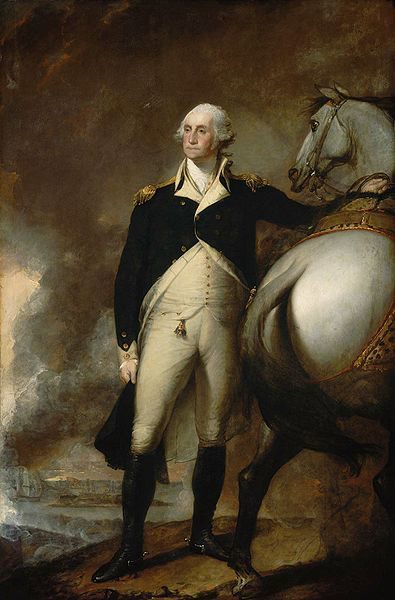
The Stuart image depicts the first president of our country as a horse’s ass – rather, in close proximity to same. And, as our friend and host for the evening suggested, the strangely proportioned George Washington – teeny tiny head on a very large body – looks for all the world like one of the aliens in “Men in Black,” the ones whose noggins pop up like pinballs from otherwise empty neck sockets.
From what might be an early example of shade, we moved on to the crown jewel of the collection, a Monet.
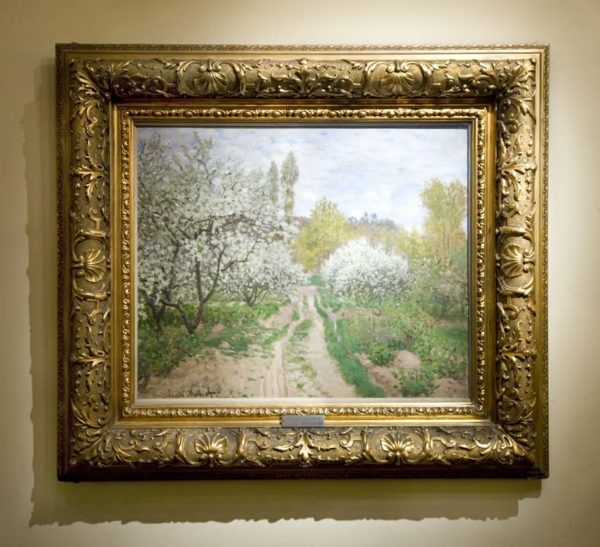
Monet’s story begins with Eugene Boudin, one of the more adventurous 19th-century painters, known primarily for his beach scenes and seascapes of northern France, and luminous skies. When Boudin taught his young student, Claude Monet, the importance of painting a scene directly from nature in the light, in the air, just as it was, painting en plein air was born. In the stroke of Monet’s agitated brush, the dark palette of Realism (and the Barbizon School) gave way to the brighter highlights of painting directly from nature.
Monet quickly introduced friends such as Renoir, Sisley, Bazille, Manet, Degas, and Bonnard to the core idea of the discipline: record only what is visible at given distances under specific lighting conditions.
In December 1873, outdoor painting sessions and heated café discussions among young artists of the day culminated in the Société Anonyme des Artists. The group’s first show, April 15, 1874, included an image by Monet of dawn over a foggy harbor entitled “Impression: Sunrise.” One critic wrote a satirical review, sniffing at the Monet in particular, and in a stroke of his venomous pen, he popularized the term “Impressionism,” now synonymous with plein air painting.
The first important Impressionist work to be shown in America was Manet’s “Execution of the Emperor Maximilian,” banned by Paris censors and politically inflammatory. According to art critic Robert Hughes, in 1879 the image was brought to New York and Boston by an opportunistic singer named Madame Ambre, who put on a show to generate publicity for her recitals.
In 1885 or 1886, the popular art dealer Paul Durand-Ruel mounted the first professional show of Impressionist images at the American Art Association’s galleries. Thus began America’s love affair with fine European works of art and explains why this country has more Impressionist works than anywhere else in the world outside France.
One of the paintings is Monet’s “Pommiers en fleurs” or “Apple Trees in blossom,” done in the spring of 1872 shortly after the artist and his family moved to Argenteuil, a resort town on the Seine.
“Apple Trees,” first shown in the Impressionists Second Exhibition of 1876 in Paris, now hangs unceremoniously on a wall near a stairway in the venerable club. And since the institution is not a museum, there are no guards, no red velvet ropes to restrict your view.
Research – and our guide, a close friend and stalwart club member – suggest “Apple Trees” was purchased by Art Committee chair and collector Judge John Barton Payne in March 1895, one of four Union League members who helped Chicago gain major prominence in the art world.
Payne personally acquired the piece, valued in a show at the Art Institute at $1500, then turned around and sold it to the club the same year for $500.
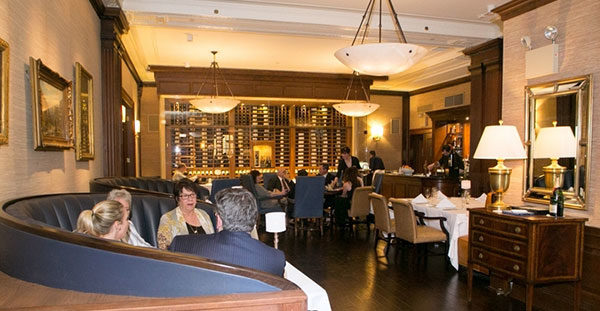
Bar area at Union League Club just outside the 3rd floor dining room.
Following the tour, our party of four sat down for drinks and then an elegant dinner in one of the club’s several swish dining halls, where ours was one of only two tables occupied for the evening.
Nice work if you can get it.
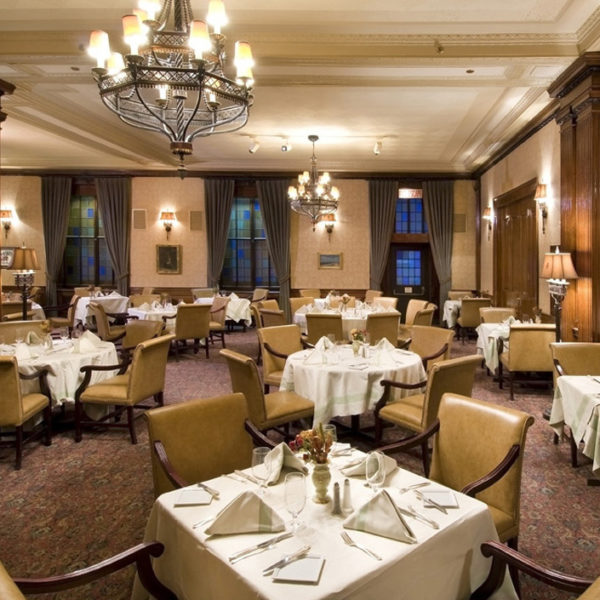
Risotto with barramundi and a side of stimulating conversation, a pleasure – and a rarity – in a world where restaurant quiet dining is an oxymoron.
What’s more, beyond the marble and dark wood of the Union League’s interior, behind the fine art and fine dining, beats a bleeding heart which supports, among other philanthropic ventures, a Boys & Girls Club of America affiliate, with our friend one of its passionate supporters.
Buttoned up, still yes.
But at the Union League Club, men no longer need to wear ties to dinner.
(Jackets yes.)
Denim is allowed on some floors.
And a recent past president was openly gay – and a woman.
We were surprised when our host shared that news?
Admittedly, a bit.
But pleasantly.
Just as we were when we first arrived in Chicago and met friends for dinner at Elske – which means “love” in Danish.
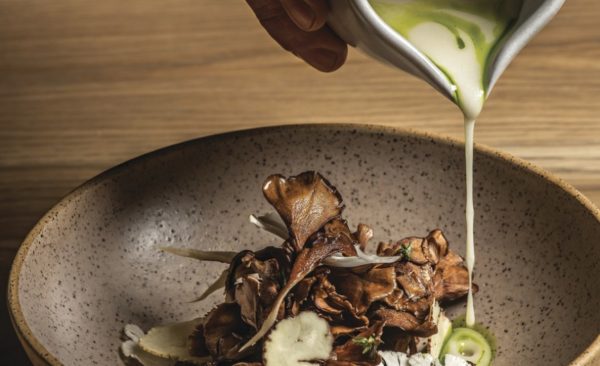
Bon Appetit voted Elske #2 in America in 2017 – and with good reason: the unpretentious watering hole dishes up huge helpings of hygge (pronounced hoo-guh) – which translate to warm and welcoming American fare with a twist – brought to you by the talented husband-wife team of David and Anna Posey, the name of the place a nod to his Danish roots.

2017 Galdones Photography LLC
For an example of Posey’s creativity take just one of our four choices from the à la carte menu: whole-roasted maitake mushroom pieces interwoven with shaved cauliflower for visual and textural contrast, poured-over pear cream and shaved chestnuts.
A host who greets you at the door like a long-lost relative; candles atop rich wooden tables; nurturing waiters who feel like Mama, but look like Nike.
The vibe at Elske is just as inviting as its small plates.
A bit spendy, but you definitely get what you pay for.


Sorry, the comment form is closed at this time.